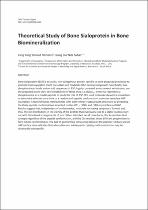JavaScript is disabled for your browser. Some features of this site may not work without it.
- ResearchSpace
- →
- Research Publications/Outputs
- →
- Journal Articles
- →
- View Item
| dc.contributor.author |
Yang, Y

|
|
| dc.contributor.author |
Mkhonto, D

|
|
| dc.contributor.author |
Cui, Q

|
|
| dc.contributor.author |
Sahai, N

|
|
| dc.date.accessioned | 2012-05-08T14:16:56Z | |
| dc.date.available | 2012-05-08T14:16:56Z | |
| dc.date.issued | 2011-05 | |
| dc.identifier.citation | Yang, Y, Mkhonto, D, Cui, Q and Sahai, N. 2011. Theoretical study of bone sialoprotein in bone biomineralization. Cells Tissues Organs, vol. 194(2-4), pp 182-187 | en_US |
| dc.identifier.issn | 1422-6405 | |
| dc.identifier.uri | http://content.karger.com/ProdukteDB/produkte.asp?Doi=324648 | |
| dc.identifier.uri | http://hdl.handle.net/10204/5848 | |
| dc.description | Copyright: 2011 Karger. This is an ABSTRACT ONLY. | en_US |
| dc.description.abstract | Bone sialoprotein (BSP) is an acidic, non-collagenous protein specific to bone proposed previously to promote hydroxyapatite (HAP) nucleation and modulate HAP nanocrystal growth. Specifically, two phosphorylated acidic amino acid sequences in BSP, highly conserved across several vertebrates, are the proposed active sites. We selected one of these sites, i.e. (Sp) 2 E 8 , where Sp represents a phosphoserine as a model peptide to study the role of BSP. We used molecular dynamics simulations to determine whether an -helix or a random coil peptide conformation promotes templated HAP nucleation. A bioinformatics method helps infer preferential crystal growth directions by predicting the likely peptide conformations adsorbed on the (001), (100), and (110) crystal faces of HAP. Results suggest that, independent of conformation, no stable nucleating template is formed and, thus, the ion distributions in the vicinity of the peptide that eventually lead to a stable nucleus start out with disordered arrangements of ions. When adsorbed on all three faces, the Sp residues bind strongly regardless of the peptide conformation, and the Glu residues show different propensities to form helical conformations. The lack of geometrical templating between the peptide residues and all HAP surface sites indicates that adsorption and subsequent crystal growth modulation may be structurally nonspecific. | en_US |
| dc.language.iso | en | en_US |
| dc.publisher | Karger | en_US |
| dc.relation.ispartofseries | Workflow;8671 | |
| dc.subject | Bone sialoprotein | en_US |
| dc.subject | Biomineralization | en_US |
| dc.subject | Nucleation | en_US |
| dc.subject | Hydroxyapatite | en_US |
| dc.subject | Computational simulation | en_US |
| dc.title | Theoretical study of bone sialoprotein in bone biomineralization | en_US |
| dc.type | Article | en_US |
| dc.identifier.apacitation | Yang, Y., Mkhonto, D., Cui, Q., & Sahai, N. (2011). Theoretical study of bone sialoprotein in bone biomineralization. http://hdl.handle.net/10204/5848 | en_ZA |
| dc.identifier.chicagocitation | Yang, Y, D Mkhonto, Q Cui, and N Sahai "Theoretical study of bone sialoprotein in bone biomineralization." (2011) http://hdl.handle.net/10204/5848 | en_ZA |
| dc.identifier.vancouvercitation | Yang Y, Mkhonto D, Cui Q, Sahai N. Theoretical study of bone sialoprotein in bone biomineralization. 2011; http://hdl.handle.net/10204/5848. | en_ZA |
| dc.identifier.ris | TY - Article AU - Yang, Y AU - Mkhonto, D AU - Cui, Q AU - Sahai, N AB - Bone sialoprotein (BSP) is an acidic, non-collagenous protein specific to bone proposed previously to promote hydroxyapatite (HAP) nucleation and modulate HAP nanocrystal growth. Specifically, two phosphorylated acidic amino acid sequences in BSP, highly conserved across several vertebrates, are the proposed active sites. We selected one of these sites, i.e. (Sp) 2 E 8 , where Sp represents a phosphoserine as a model peptide to study the role of BSP. We used molecular dynamics simulations to determine whether an -helix or a random coil peptide conformation promotes templated HAP nucleation. A bioinformatics method helps infer preferential crystal growth directions by predicting the likely peptide conformations adsorbed on the (001), (100), and (110) crystal faces of HAP. Results suggest that, independent of conformation, no stable nucleating template is formed and, thus, the ion distributions in the vicinity of the peptide that eventually lead to a stable nucleus start out with disordered arrangements of ions. When adsorbed on all three faces, the Sp residues bind strongly regardless of the peptide conformation, and the Glu residues show different propensities to form helical conformations. The lack of geometrical templating between the peptide residues and all HAP surface sites indicates that adsorption and subsequent crystal growth modulation may be structurally nonspecific. DA - 2011-05 DB - ResearchSpace DP - CSIR KW - Bone sialoprotein KW - Biomineralization KW - Nucleation KW - Hydroxyapatite KW - Computational simulation LK - https://researchspace.csir.co.za PY - 2011 SM - 1422-6405 T1 - Theoretical study of bone sialoprotein in bone biomineralization TI - Theoretical study of bone sialoprotein in bone biomineralization UR - http://hdl.handle.net/10204/5848 ER - | en_ZA |






